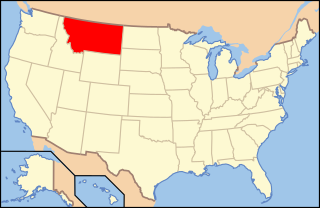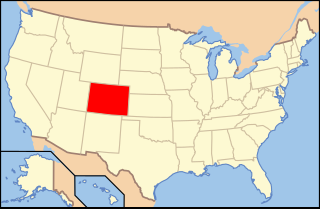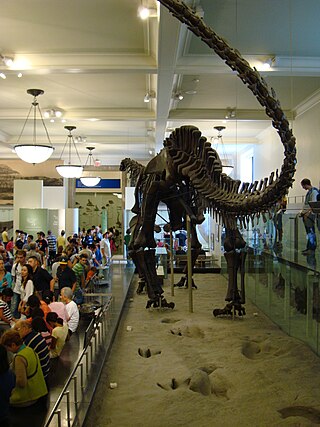
Skokholm or Skokholm Island is an island 2.5 miles (4.0 km) off the coast of Pembrokeshire, Wales, south of the neighbouring island of Skomer. The surrounding waters are a marine reserve and all are part of the Pembrokeshire Coast National Park. Both islands are listed as Sites of Special Scientific Interest.

Ronald Mathias Lockley was a Welsh ornithologist and naturalist. He wrote over fifty books on natural history, including a study of shearwaters, and the book The Private Life of the Rabbit, which was used in the development of his friend Richard Adams's children's book Watership Down.

Eubrontes is the name of fossilised dinosaur footprints dating from the Late Triassic and Early Jurassic. They have been identified from France, Poland, Slovakia, Czech Republic, Italy, Spain, Sweden, Australia (Queensland), US, India, China and Brazil (South).
The Uhangri Formation, located at the Uhangri Dinosaur Fossil Site, is a geological formation from which fossil pterosaur tracks have been recovered near Haenam-eup, Jeollanam-do, South Korea.
The Haman Formation is an Early Cretaceous geological formation in South Korea. It has been dated to the Albian, with an estimated maximum depositional age of 105.4 ± 0.4 Ma. The deposit is known for its tracks, including those of dinosaurs, pterosaurs and birds. It overlies the Silla Conglomerate which overlies the Chilgok Formation. It is laterally equivalent to the Sagog Formation.

Martin G. Lockley was a Welsh palaeontologist. He was educated in the United Kingdom where he obtained degrees and post-doctoral experience in Geology in the 1970s. Since 1980 he had been a professor at the University of Colorado at Denver, (UCD) and was later Professor Emeritus. He is best known for his work on fossil footprints and was the former director of the Dinosaur Tracks Museum at UCD. He was an Associate Curator at the University of Colorado Museum of Natural History and Research Associate at the Denver Museum of Nature and Science. During his years at UCD he earned a BA in 2007 in Spanish with a minor in Religious Studies, became a member of the Scientific and Medical Network and taught and published on the evolution of consciousness.
The Jindong Formation is a geological formation located in South Korea. It dates to the Cenomanian stage of the Late Cretaceous, with a maximum depositional age of 99.9 ± 0.7 Ma.
The Jinju Formation is an Early Cretaceous geologic formation in South Korea. Dinosaur remains are among the fossils that have been recovered from the formation, although none have yet been referred to a specific genus. The depositional age of this formation spans from approximately 112.4 ± 1.3 to 106.5 million years ago based on detrital zircon U-Pb dating. It predominantly consists of black shale, with sandstone packets, deposited in a fluvial-lacustrine setting.
Dalingheornis is a genus of enantiornithean birds which lived during the early Cretaceous period, about 122 Ma ago, and are known from a single juvenile fossil found in the upper part of the Yixian Formation at Dawangzhangzi, Liaoning province, People's Republic of China. It is the first known Mesozoic bird with heterodactyl feet specifically adapted for climbing, and was probably among the most arboreal of the enantiornithines. Unlike its relatives, it had an unusually long (17mm) skeletal tail made up of 20 vertebrae, similar to the tails of dromaeosaurids. However, this may have been a juvenile feature. The fossil was named after Yang Liwei, the first Chinese astronaut in space.

Caririchnium is an ichnogenus of ornithopod dinosaur footprint, belonging to either derived iguanodonts or basal hadrosauroids. It includes the species Caririchnium lotus from Lower Cretaceous Jiaguan Formation and C. protohadrosaurichnos from Upper Cretaceous Woodbine Formation. Specimens are also known from the Lower Cretaceous El Castellar Formation and Camarillas Formations.

Brianne Theisen-Eaton is a retired Canadian track and field athlete who competed in the heptathlon and women's pentathlon. She won the bronze medal at the 2016 Summer Olympics. Theisen-Eaton holds the Canadian record for the heptathlon with 6,808 points, as well as the indoor pentathlon with a score of 4768 points. Theisen-Eaton is a heptathlon silver medallist from the 2013 World Championships and 2015 World Championships, as well as a pentathlon silver medalist from the 2014 World Indoor Championships. She is the first and only Canadian woman to podium in the multi-events at the World Championships. Theisen-Eaton won Commonwealth Games gold in the heptathlon at Glasgow 2014 and was the 2016 World Indoor Champion in the pentathlon. She also won a bronze medal as part of the women's 4 x 400 m relay at the 2015 Pan American Games in Toronto.

Animal navigation is the ability of many animals to find their way accurately without maps or instruments. Birds such as the Arctic tern, insects such as the monarch butterfly and fish such as the salmon regularly migrate thousands of miles to and from their breeding grounds, and many other species navigate effectively over shorter distances.

Paleontology in Texas refers to paleontological research occurring within or conducted by people from the U.S. state of Texas. Author Marian Murray has said that "Texas is as big for fossils as it is for everything else." Some of the most important fossil finds in United States history have come from Texas. Fossils can be found throughout most of the state. The fossil record of Texas spans almost the entire geologic column from Precambrian to Pleistocene. Shark teeth are probably the state's most common fossil. During the early Paleozoic era Texas was covered by a sea that would later be home to creatures like brachiopods, cephalopods, graptolites, and trilobites. Little is known about the state's Devonian and early Carboniferous life. Evidence indicates that during the late Carboniferous the state was home to marine life, land plants and early reptiles. During the Permian, the seas largely shrank away, but nevertheless coral reefs formed in the state. The rest of Texas was a coastal plain inhabited by early relatives of mammals like Dimetrodon and Edaphosaurus. During the Triassic, a great river system formed in the state that was inhabited by crocodile-like phytosaurs. Little is known about Jurassic Texas, but there are fossil aquatic invertebrates of this age like ammonites in the state. During the Early Cretaceous local large sauropods and theropods left a great abundance of footprints. Later in the Cretaceous, the state was covered by the Western Interior Seaway and home to creatures like mosasaurs, plesiosaurs, and few icthyosaurs. Early Cenozoic Texas still contained areas covered in seawater where invertebrates and sharks lived. On land the state would come to be home to creatures like glyptodonts, mammoths, mastodons, saber-toothed cats, giant ground sloths, titanotheres, uintatheres, and dire wolves. Archaeological evidence suggests that local Native Americans knew about local fossils. Formally trained scientists were already investigating the state's fossils by the late 1800s. In 1938, a major dinosaur footprint find occurred near Glen Rose. Pleurocoelus was the Texas state dinosaur from 1997 to 2009, when it was replaced by Paluxysaurus jonesi after the Texan fossils once referred to the former species were reclassified to a new genus.

Paleontology in Montana refers to paleontological research occurring within or conducted by people from the U.S. state of Montana. The fossil record in Montana stretches all the way out to sea]] where local bacteria formed stromatolites and bottom-dwelling marine life left tracks on the sediment that would later fossilize. This sea remained in place during the early Paleozoic, although withdrew during the Silurian and Early Devonian, leaving a gap in the local rock record until its return. This sea was home to creatures including brachiopods, conodonts, crinoids, fish, and trilobites. During the Carboniferous the state was home to an unusual cartilaginous fish fauna. Later in the Paleozoic the sea began to withdraw, but with a brief return during the Permian.

Paleontology in Colorado refers to paleontological research occurring within or conducted by people from the U.S. state of Colorado. The geologic column of Colorado spans about one third of Earth's history. Fossils can be found almost everywhere in the state but are not evenly distributed among all the ages of the state's rocks. During the early Paleozoic, Colorado was covered by a warm shallow sea that would come to be home to creatures like brachiopods, conodonts, ostracoderms, sharks and trilobites. This sea withdrew from the state between the Silurian and early Devonian leaving a gap in the local rock record. It returned during the Carboniferous. Areas of the state not submerged were richly vegetated and inhabited by amphibians that left behind footprints that would later fossilize. During the Permian, the sea withdrew and alluvial fans and sand dunes spread across the state. Many trace fossils are known from these deposits.
Archaeornithipus was a genus of large bird ichnogenus discovered in Spain. The tracks date back to the Berriasian stage of the Cretaceous, making them among the oldest bird trace fossils in the world.

The 20th century in ichnology refers to advances made between the years 1900 and 1999 in the scientific study of trace fossils, the preserved record of the behavior and physiological processes of ancient life forms, especially fossil footprints. Significant fossil trackway discoveries began almost immediately after the start of the 20th century with the 1900 discovery at Ipolytarnoc, Hungary of a wide variety of bird and mammal footprints left behind during the early Miocene. Not long after, fossil Iguanodon footprints were discovered in Sussex, England, a discovery that probably served as the inspiration for Sir Arthur Conan Doyle's The Lost World.

The 19th century in ichnology refers to advances made between the years 1800 and 1899 in the scientific study of trace fossils, the preserved record of the behavior and physiological processes of ancient life forms, especially fossil footprints. The 19th century was notably the first century in which fossil footprints received scholarly attention. British paleontologist William Buckland performed the first true scientific research on the subject during the early 1830s.

Terri Janke is an Indigenous Australian lawyer of Wuthathi/Meriam heritage. She is considered a leading international authority on Indigenous cultural and intellectual property (ICIP), and is the Solicitor Director of Terri Janke and Company.
Wakinyantanka is an ichnogenus of footprint produced by a large theropod dinosaur from the Late Cretaceous Hell Creek Formation of South Dakota. Wakinyantanka tracks are large with three long, slender toes with occasional impressions of a short hallux and narrow metatarsals. Wakinyantanka was the first dinosaur track to be discovered in the Hell Creek Formation, which remain rare in the preservational conditions of the rocks. The potential trackmakers may be a large oviraptorosaur or a small tyrannosaurid.












